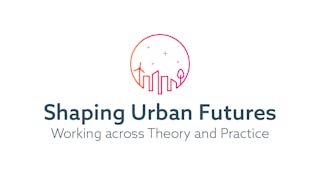Latin American cities are still growing in an uncontrolled way, due to informal place occupation and the absence of urban planning policies, generating the construction of informal human settlements. In this vulnerable urban context, many children are born and raised without having access to safe, inclusive and stimulating public spaces.



Recommended experience
Recommended experience
What you'll learn
Identify your intrinsic motivators and determine a focus area to start your social change journey
Explore and apply design thinking as a tool to enact social change in your community
Deliver a tangible, actionable plan to make a difference in yourself, your community and to the greater movement for social change
Expand your social change network, and reflect on and assess strengths and weaknesses in your skillset to enhance your social change journey
Skills you'll gain
Details to know

Add to your LinkedIn profile
16 assignments
See how employees at top companies are mastering in-demand skills

There are 7 modules in this course
Welcome to the first Module of the MOOC “Urban Landscapes of Care - Thinking and designing child-friendly cities”! In this first week, we will give you a short introduction to the course and its challenge involved: to improve our cities for small children and their caregivers through the design and development of an Urban Landscape of Care. To begin, we will learn about experiential urban analysis methods and how to apply them during an exploratory walk through the city. With that tool, we can gain a more empathetic and inclusive perspective towards the urban environment in which we live and work. The first practical exercise will be the start of the project we will develop throughout the course. We will also discuss the diversity of our cities, the different actors and social groups inhabiting the territory, their needs, dreams, and finally their relationship with the built environment.
What's included
9 videos8 readings2 assignments3 discussion prompts4 plugins
Welcome to the second week of our MOOC! The second module will be divided into three main topics; the composed city, the public city, and the city that cares which will be summarized in a final reflection that interpellates the questions on: What is it that composes our cities? What does public space mean? What defines a good public space? What is the difference between public space, urban environment, and an urban landscape? What is an"Urban Landscape of Care"? and, Who requires an urban landscape of care and why? All those questions we will tackle in this second Module of the MOOC "Urban Landscapes of Care".
What's included
5 videos4 readings3 assignments4 discussion prompts2 plugins
In this third week of the course, we will learn about early childhood development and its relation with the urban space based on the experience of young children. Also, we will show the importance that early years have for brain development and cognitive abilities. Based on these concepts we will understand the city as a learning platform that has to answer to their expectations and needs.
What's included
5 videos3 readings5 assignments2 discussion prompts1 plugin
In the fourth week of this course, we will learn about the characteristics, elements and design strategies for an Urban Landscape of Care for small children and their caregivers. This will include design principles, stakeholders identification, and how the interaction between the small child and an Urban Landscape of Care can contribute to child development. s the Internet has had on the world.
What's included
7 videos3 readings2 assignments1 peer review2 discussion prompts1 plugin
In the fifth week of the course, we will learn about the design tools we can apply in the development of an Urban Landscape of Care. Apart we will reflect and learn about the role and stages of community engagement work that can accompany the design process. As well, you will explore different participatory tools that can help you to engage with your community. Finally, we will discuss the strategies and possibilities to make our projects sustainable in time.
What's included
5 videos7 readings3 assignments4 discussion prompts4 plugins
Welcome to the sixth week of the MOOC "Urban Landscapes of Care - Thinking and designing child-friendly cities". In this module, we will learn about the importance of communicating our projects – graphically and through an inspiring presentation. Therefore we will explore a series of tools to represent graphically and communicate the design of our Urban Landscape of Care. Apart from that, we will talk about the steps that follow the design phase of our project, such as the management of time, stakeholders and the available resources.In the process, we will raise the following questions: How do we communicate with all the stakeholders involved? How do we organize the implementation phase of our project? What resources do we have available and what others do we need to realize the project? Finally, this module gives us the opportunity to reflect on the phenomenon of "between control and uncertainty" and how we as planners can respond to these particular moments within a project. As a result of this week we will elaborate the implementation roadmap for the Urban Landscape of Care we are developing in this course. Enjoy!
What's included
6 videos3 readings1 peer review6 discussion prompts1 plugin
Welcome to our last module of the MOOC “Urban Landscapes of Care - Thinking and designing child-friendly cities”! In this last module of the course we will learn about how to close the cycle of a project - in Module 5 we called it the “transformation cycle”. In that sense we will talk about impact measuring tools and the possible steps of rethinking, re-planning, replicating or up-scaling our projects. Further we will evaluate our learning process within the whole course. We will travel in time and review the milestones of the MOOC. And finally we will come to our very last reflection of the course: If we are able to develop urban landscapes of care for young children and their caregivers at a small neighborhood scale, is it possible that also our cities become urban landscapes of care? What would they look like? Could this vision give us a perspective on how to plan and build our future cities and neighborhoods as safe, inclusive and stimulating spaces not only for young children, but for everybody?Join the discussion. We hope you enjoy the last module of the course!
What's included
3 videos3 readings1 assignment2 plugins
Earn a career certificate
Add this credential to your LinkedIn profile, resume, or CV. Share it on social media and in your performance review.
Instructors



Explore more from Education
 Status: Preview
Status: Preview
University of Copenhagen
 Status: Free Trial
Status: Free Trial
Lund University
 Status: Free Trial
Status: Free Trial
Johns Hopkins University
 Status: Preview
Status: Preview
Indian Institute for Human Settlements
Why people choose Coursera for their career





Open new doors with Coursera Plus
Unlimited access to 10,000+ world-class courses, hands-on projects, and job-ready certificate programs - all included in your subscription
Advance your career with an online degree
Earn a degree from world-class universities - 100% online
Join over 3,400 global companies that choose Coursera for Business
Upskill your employees to excel in the digital economy
Frequently asked questions
Access to lectures and assignments depends on your type of enrollment. If you take a course in audit mode, you will be able to see most course materials for free. To access graded assignments and to earn a Certificate, you will need to purchase the Certificate experience, during or after your audit. If you don't see the audit option:
The course may not offer an audit option. You can try a Free Trial instead, or apply for Financial Aid.
The course may offer 'Full Course, No Certificate' instead. This option lets you see all course materials, submit required assessments, and get a final grade. This also means that you will not be able to purchase a Certificate experience.
When you purchase a Certificate you get access to all course materials, including graded assignments. Upon completing the course, your electronic Certificate will be added to your Accomplishments page - from there, you can print your Certificate or add it to your LinkedIn profile. If you only want to read and view the course content, you can audit the course for free.
You will be eligible for a full refund until two weeks after your payment date, or (for courses that have just launched) until two weeks after the first session of the course begins, whichever is later. You cannot receive a refund once you’ve earned a Course Certificate, even if you complete the course within the two-week refund period. See our full refund policy.
More questions
Financial aid available,

